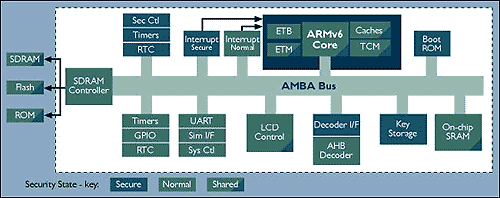De heren van PC World melden dat chipontwerper ARM een serie beveiligingsextensies gaat implementeren in de volgende serie mobiele chips. De uitbreiding heet TrustZone en zorgt ervoor dat niet alle instructies en gegevens beschikbaar zijn voor een willekeurige applicatie. Het besturingssysteem en de producent van de software bepalen welke gegevens beveiligd moet worden. Dit wordt vervolgens hardwarematig in de chip aangegeven met een S-bit (security bit). Om te garanderen dat het besturingssysteem in orde is, wordt dit gestart vanuit de TrustZone. ARM probeert met deze extensies een standaard voor mobiele apparatuur te vormen, maar er zijn meer kapers op de kust:
Just about all companies in the microprocessor industry are working on hardware-based security features, which free up system resources normally dedicated to security software products; they also execute tasks such as random number generation much faster than software.
[..] But skeptics are concerned about the ease with which these hardware-based security features could be used by vendors to set digital rights management policies.
Since the device makers, operating system vendors, and application providers decide what data is secure and what isn't, they can set policies on the device so that it will play only certain types of media files, monitor the way the device is used, or even log keystrokes. The user will have no access to the TrustZone controls in ARM's product, Inglis said.


/i/1256287480.png?f=fpa)